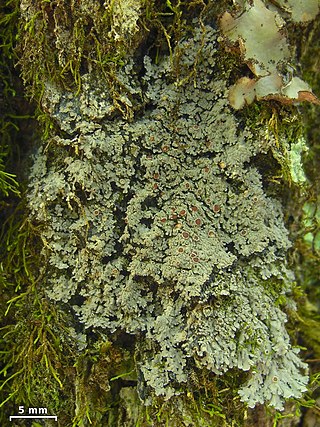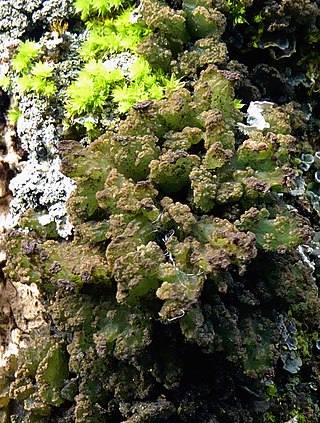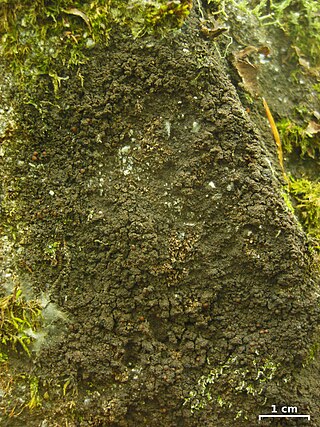
The Pannariaceae are a family of lichens in the order Peltigerales. Species from this family have a widespread distribution, but are especially prevalent in southern temperate regions.

The Baeomycetales are an order of mostly lichen-forming fungi in the subclass Ostropomycetidae, in the class Lecanoromycetes. It contains 8 families, 33 genera and about 170 species. As a result of molecular phylogenetics research published in the late 2010s, several orders were folded into the Baeomycetales, resulting in a substantial increase in the number of taxa.

Protopannaria is a genus of seven species of lichenized fungi in the family Pannariaceae. The genus was originally circumscribed as a subgenus of the genus Pannaria by Hungarian lichenologist Vilmos Kőfaragó-Gyelnik. Per Magnus Jørgensen and Stefan Ekman promoted Protopannaria to full status as a genus in 2000.

Fuscopannaria is a genus of lichen-forming fungi in the family Pannariaceae. It has 55 species.

Leptogium is a genus of lichen-forming fungi in the family Collemataceae. It has about 110 species. Species formerly classified under Leptogium have since been divided among the genera Leptogium, Pseudoleptogium, and Scytinium. Leptogium lichens are predominantly found on tree bark or soil, often among mosses, and sometimes on rocks in moist environments.
Leciophysma is a genus of cyanolichens in the family Pannariaceae. It has four species. The genus was circumscribed by Theodor Magnus Fries in 1865, with Leciophysma finmarkicum assigned as the type species.

The Arctomiaceae are a family of lichenized fungi in the Ascomycota, class Baeomycetales. The family was named by Theodor Magnus Fries in 1861, with Arctomia as the type genus. Species in this family are found in arctic and subarctic habitats, usually associated with bryophytes.
Lepidocollema wainioi is a species of lichen in the family Pannariaceae. It is known from southeast Asia.

Vahliella is a genus of nine species of lichen-forming fungi in the order Peltigerales. It is the only member of Vahliellaceae, a family circumscribed in 2010 to contain this genus. Vahliella was formerly placed in the family Pannariaceae until molecular phylogenetics showed that it did not belong there. Vahliella species are found in the Northern Hemisphere – mainly in North America, but also in Europe and India.
Gibbosporina is a genus of 13 species of foliose lichens in the family Pannariaceae. It contains species that molecular phylogenetic analysis clustered together in a clade previously referred to as the "Physma"-group. Despite their morphological differences, this group shares several uniting characteristics. They have ring-like excipular margins around the thallus; strongly amyloid internal ascus structures; well-developed perispores that feature irregular gibbae, but not verrucae ; lacks secondary compounds than can be detected by thin-layer chromatography; and have tropical distributions.

Blennothallia is a genus of jelly lichens in the family Collemataceae. It has four species, which collectively have a cosmopolitan distribution.

Scytinium is a genus of lichen-forming fungi in the family Collemataceae. It has 49 species. These lichens are typically found on basic rocks, soil, and trees, occasionally in association with mosses. Despite the morphological and ecological diversity within Scytinium, its species share similar ascospore features, such as shape and septation, as well as a small to medium-sized thallus with at least a partial cortex.

Lathagrium is a genus of lichen-forming fungi in the family Collemataceae. It has 10 species of gelatinous lichens. Species in this genus typically grow on calcareous rocks, often amidst mosses, but can also be found on siliceous or serpentine rocks, mortar, or soil.

Massalongiaceae is a small family of lichen-forming fungi in the order Peltigerales. It has three genera and seven species.

Lepidocollema marianum is a species of cyanolichen in the family Pannariaceae. It was first scientifically described by Elias Fries in 1825 as Parmelia mariana. Per Magnus Jørgensen transferred it to the genus Lepidocollema in 2014 following a molecular phylogenetics-guided revision of the Pannariaceae.

Gabura is a genus of lichen-forming fungi in the family Arctomiaceae. Although it was originally circumscribed in 1763 by French botanist Michel Adanson, the name was nomen rejiciendum–it was "suppressed" against the conserved name Collema, and for a long time considered a synonym of Arctomia. In 2014, Per Magnus Jørgensen proposed to use the name Gabura for what was then known as Collema fasciculare. The name was formally resurrected for use in 2020. Gabura has three species transferred from the genus Arctomia following molecular phylogenetic analysis.

Rostania is a genus of lichen-forming fungi in the family Collemataceae. These lichens are primarily found on tree bark, occasionally on wood, with one species known to inhabit soil. The genus is characterized morphologically by having minute thalli made of hyphal tissue without a separate cortex, and the more or less cuboid-shaped ascospores.

The Collematineae are an suborder of rust fungi in the order of Peltigerales in the class Lecanoromycetes.

Gabura borbonica, previously known as Arctomia borbonica, is a species of foliose lichen found on Réunion, an island in the Mascarene archipelago. This species is unique due to its distinct features such as a crumpled, blue-grey to brown thallus and the production of structures called goniocysts at its margins. G. borbonica was transferred to the genus Gabura in 2020, and is distinguished from its sister species, Gabura insignis, both genetically and morphologically.

Hondaria is a single-species fungal genus in the family Collemataceae. It contains the species Hondaria leptospora, a corticolous (bark-dwelling), foliose lichen. This lichen was previously classified under the genus Collema, and later Arctomia, but molecular research combined with morphological analysis indicates that it forms a distinct genus. Named in honour of Dr. Neli Kika Honda, a researcher of lichen chemistry, Hondaria leptospora is notable for its long, thin, transversely-septate ascospores, the longest within its family. The species is found predominantly in the west-central regions of Brazil near the borders with Bolivia and Paraguay.















